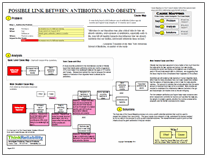By Kim Smiley
Medical residents work extremely long, tiring schedules on their arduous path to becoming physicians. Possible consequences of this demanding schedule have long been debated. Many wonder if it’s safe to have someone who has been on duty for 24 hours straight treating patients.
This issue can be explored by building a Cause Map, or visual root cause analysis. A Cause Map is built by asking “why” questions and laying out the different causes that contributed to an issue to the cause-and-effect relationships. In this example, there is potential risk to patients and to the medical residents themselves. Patients may be at risk because fatigued medical residents are treating patients and fatigued people are more likely to make mistakes, increasing the chance of a medical error that affects patient safety. Residents are fatigued because they work long hours and the current regulations allow 80 hour work weeks.
Additionally, the health of the residents themselves may be at risk. A poll by the Mayo clinic found that 11 percent of medical residents had been in an auto accident. The poll also found that 8 percent of residents reported having at least one blood or body fluid exposure due to fatigue or stress, potentially exposing them to any number of diseases. Sleep deprivation itself can also have long term health consequences increasing the likelihood of a number of illness including heart disease and gastrointestinal problems.
While there is ongoing debate on whether residents are still working too many hours, there have been changes made to reduce resident fatigue. In 2003, residents were limited to 80 hours per week by the Accreditation Council for Graduate Medical Education. Prior to this move, there was essentially no limit to the hours a resident could log. This issue isn’t black and white and there are also many who argue that the limits have had negative unintended consequences. Fewer hours in the hospital mean that residents see fewer patients and have less experience when they become independent physicians. Limiting shifts also increases the potential for each patient to be seen by more doctors and for essential information to be lost during turnovers. This isn’t an issue with a clear answer and any additional restrictions in the hours a resident is allowed to work will need to be mitigated with effective methods of turning over patient care and assurances that residents are getting adequate training.
This is a good example to demonstrate the important of taking an investigation past determining that the problem is caused by “human error”. Medical errors are caused by human errors, but the most useful part of the investigation usually comes from asking why the error was made. Was the person overly fatigued? Was the procedure confusing? Would the process go smoother with a phase to verify information or a checklist? An investigation shouldn’t be stopped at “human error”; it should be taken a few steps farther to see what may have contributed to the error and what changes may help prevent a similar error in the future.






